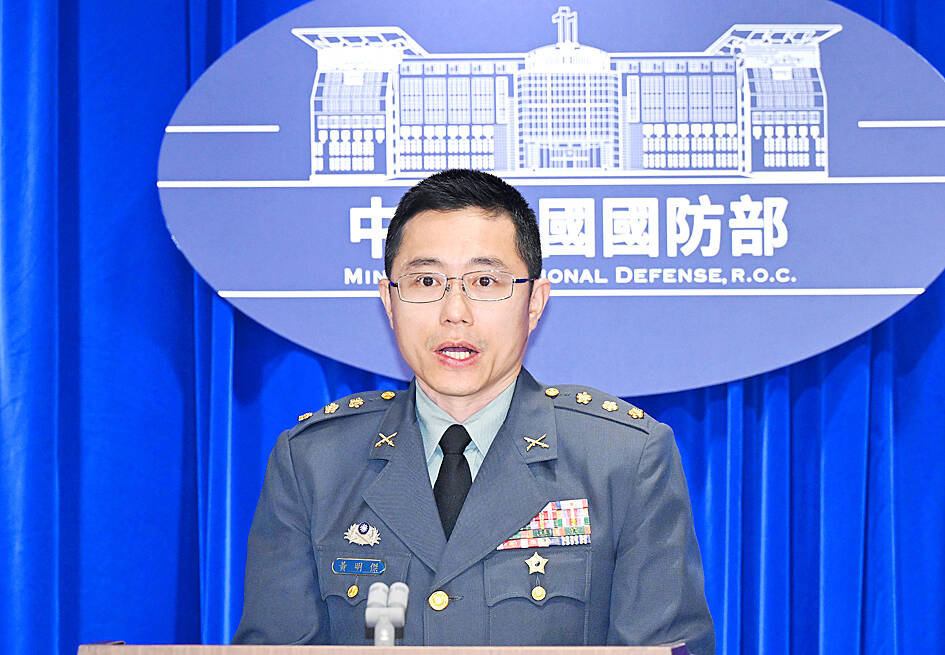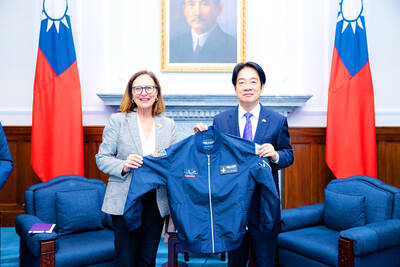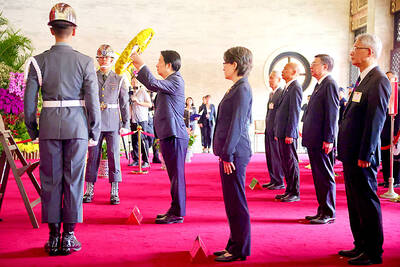Taiwanese should have greater faith in the government’s investigation into the capsizing of a Chinese vessel that resulted in the death of two Chinese fishers last week, the Coast Guard Administration (CGA) said yesterday, adding that Taiwan abides by the rule of law.
On Wednesday last week, a Chinese speedboat was spotted trespassing in “prohibited” waters within 1.1 nautical miles (2km) of the east coast of Kinmen. It fled after refusing the coast guard’s request to board the vessel, setting off a chase that led to the boat capsizing, with two Chinese fishers dying. Two survivors were deported back to China on Tuesday after Kinmen prosecutors questioned them.
Kinmen District Chief Prosecutor Shih Chia-jung (施家榮) said that the office cannot confirm or deny whether a CGA ship had collided with the Chinese boat multiple times during the pursuit.

Photo: Liao Chen-huei, Taipei Times
A preliminary investigation showed that the CGA vessel did not have ship-borne recording equipment, the Kinmen District Prosecutors’ Office said.
The crew member tasked with recording could not access the handheld equipment due to the high-speed chase, while the captain was occupied with navigation and two other crew were preparing to board the speedboat, the coast guard said.
The CGA said it would assist the family members of the deceased fishers, and would comply with investigations.
In a regional press call, US National Security Adviser Jake Sullivan said that Washington has been clear on its stance on maintaining peace and stability across the Taiwan Strait.
Although he declined to comment specifically on the Kinmen incident, he said that the US is “against any kind of action, by any party, that undermines that peace and stability.”
At a news briefing on Tuesday, US Department of State spokesman Matthew Miller said that Washington is closely monitoring Beijing’s actions, while it continues to “urge restraint and no unilateral change to the status quo.”
The US also urged China to engage in meaningful dialogue with Taiwan to reduce the risk of miscalculation, Miller said.
In Taipei, the Ministry of National Defense said that it has no intention to “directly intervene” in an ongoing maritime dispute with Beijing to avoid escalating tensions.
Ministry joint operations planning section Captain Lee Chang-fu (李昌富) said the case that triggered the dispute is under the jurisdiction of the CGA and is under investigation.
The military is keeping a close eye on the situation and would let the CGA do its job based on the principles of “no direct involvement, no escalating of tension,” he said.
The military has elected not to bolster defenses in the Kinmen, Matsu and Penghu islands following the incident, Lee said, adding that the military has contingency measures in place should tensions with China escalate.
“Our navy and the defense forces of the outlying islands will conduct exercises and preparations in response to the situation,” ministry spokesperson Sun Li-fang (孫立方) said. “In the face of the threat, we hope the situation can be effectively and properly handled.”
Ministry intelligence officer Colonel Huang Ming-chieh (黃明傑) said there was currently “nothing abnormal” in China’s military movements around Taiwan.
Additional reporting by Reuters

RESPONSE: The transit sends a message that China’s alignment with other countries would not deter the West from defending freedom of navigation, an academic said Canadian frigate the Ville de Quebec and Australian guided-missile destroyer the Brisbane transited the Taiwan Strait yesterday morning, the first time the two nations have conducted a joint freedom of navigation operation. The Canadian and Australian militaries did not immediately respond to requests for comment. The Ministry of National Defense declined to confirm the passage, saying only that Taiwan’s armed forces had deployed surveillance and reconnaissance assets, along with warships and combat aircraft, to safeguard security across the Strait. The two vessels were observed transiting northward along the eastern side of the Taiwan Strait’s median line, with Japan being their most likely destination,

‘NOT ALONE’: A Taiwan Strait war would disrupt global trade routes, and could spark a worldwide crisis, so a powerful US presence is needed as a deterrence, a US senator said US Senator Deb Fischer on Thursday urged her colleagues in the US Congress to deepen Washington’s cooperation with Taiwan and other Indo-Pacific partners to contain the global security threat from China. Fischer and other lawmakers recently returned from an official trip to the Indo-Pacific region, where they toured US military bases in Hawaii and Guam, and visited leaders, including President William Lai (賴清德). The trip underscored the reality that the world is undergoing turmoil, and maintaining a free and open Indo-Pacific region is crucial to the security interests of the US and its partners, she said. Her visit to Taiwan demonstrated ways the

GLOBAL ISSUE: If China annexes Taiwan, ‘it will not stop its expansion there, as it only becomes stronger and has more force to expand further,’ the president said China’s military and diplomatic expansion is not a sole issue for Taiwan, but one that risks world peace, President William Lai (賴清德) said yesterday, adding that Taiwan would stand with the alliance of democratic countries to preserve peace through deterrence. Lai made the remark in an exclusive interview with the Chinese-language Liberty Times (sister paper of the Taipei Times). “China is strategically pushing forward to change the international order,” Lai said, adding that China established the Asia Infrastructure Investment Bank, launched the Belt and Road Initiative, and pushed for yuan internationalization, because it wants to replace the democratic rules-based international

WAR’S END ANNIVERSARY: ‘Taiwan does not believe in commemorating peace by holding guns,’ the president said on social media after attending a morning ceremony Countries should uphold peace, and promote freedom and democracy, President William Lai (賴清德) said yesterday as Taiwan marked 80 years since the end of World War II and the Second Sino-Japanese War. Lai, Vice President Hsiao Bi-khim (蕭美琴) and other top officials in the morning attended a ceremony at the National Revolutionary Martyrs’ Shrine in Taipei’s Zhongshan District (中山) to honor those who sacrificed their lives in major battles. “Taiwanese are peace-loving. Taiwan does not believe in commemorating peace by holding guns,” Lai wrote on Facebook afterward, apparently to highlight the contrast with the military parade in Beijing marking the same anniversary. “We